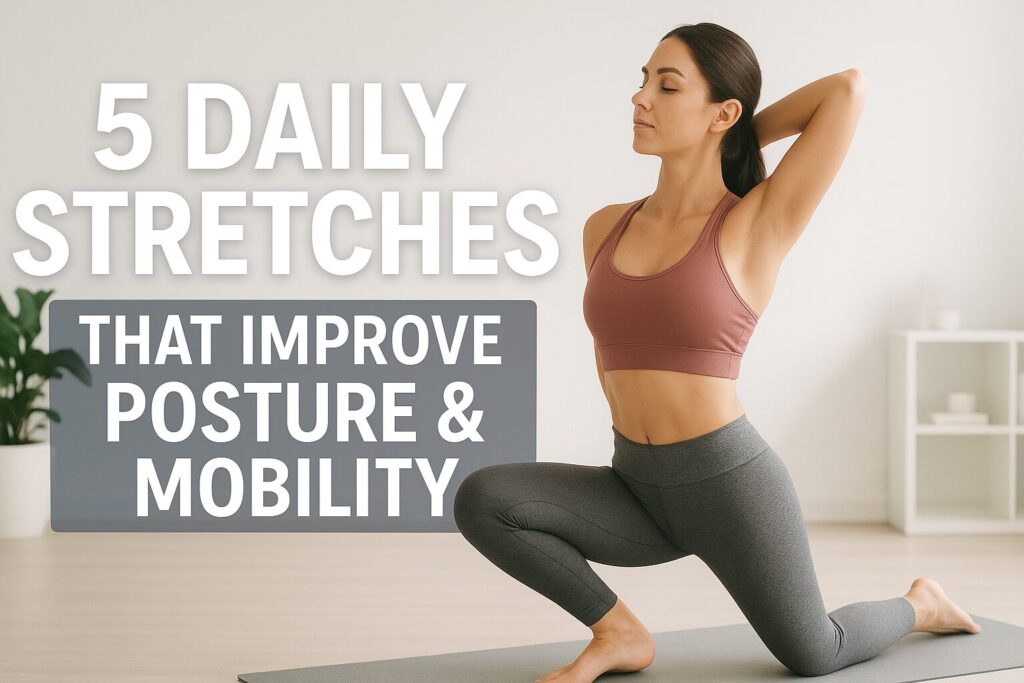Discover 5 daily stretches that improve posture and mobility, reduce back and shoulder tension, and enhance flexibility. Easy home stretches for better health and comfort.
Table of Contents
Introduction: Why Daily Stretching Matters for Posture and Mobility
Maintaining good posture and overall mobility is essential for both daily activities and long-term health. Unfortunately, sedentary lifestyles, prolonged sitting, and repetitive movements can lead to rounded shoulders, tight hips, and restricted spinal flexibility. This is where Daily Stretches That Improve Posture and Mobility come into play.
Engaging in a consistent stretching routine helps lengthen muscles, increase joint range of motion, and alleviate tension in areas that are prone to stiffness. Research has shown that regular stretching can reduce musculoskeletal discomfort, improve spinal alignment, and even enhance athletic performance (source).
By incorporating targeted stretches into your daily routine, you can counteract the negative effects of modern sedentary habits, promote proper alignment, and maintain functional mobility throughout life. Whether you work at a desk, perform manual labor, or are an athlete, these stretches provide foundational benefits for strength, flexibility, and overall wellness.
In the following sections, we’ll explore five effective stretches specifically designed to improve posture and mobility, along with practical tips for making them part of your everyday routine.
Stretch 1: Chest Opener to Prevent Rounded Shoulders
Rounded shoulders are one of the most common postural issues caused by prolonged sitting, smartphone use, or desk work. Tight chest muscles pull the shoulders forward, which can lead to upper back pain, tension, and reduced mobility. A chest opener stretch counteracts this by lengthening the pectoral muscles and promoting proper shoulder alignment.
How to Perform the Chest Opener Stretch:
- Stand tall with your feet shoulder-width apart.
- Clasp your hands behind your back, interlacing your fingers.
- Straighten your arms and gently lift your hands upward while squeezing your shoulder blades together.
- Hold the stretch for 20–30 seconds, breathing deeply.
- Repeat 2–3 times, gradually increasing the lift without straining.
Tips for Maximum Effectiveness:
- Keep your neck relaxed and avoid overarching your lower back.
- For beginners, using a towel or strap between your hands can make the stretch more comfortable.
- Incorporate this stretch in the morning or after prolonged sitting to reduce tension buildup.
Why It Works:
This stretch targets the pectoralis major and minor muscles, which are often shortened due to forward-leaning postures. By lengthening these muscles, you allow the shoulders to naturally fall back, improving spinal alignment and reducing the risk of upper back discomfort. According to posture experts, regular chest-opening stretches can significantly alleviate postural imbalances and support a more upright, confident stance (source).
Stretch 2: Upper Back Stretch for Improved Spine Alignment
A strong and flexible upper back is essential for maintaining proper posture and preventing spinal discomfort. Prolonged sitting, slouching, or hunching over devices can lead to stiffness in the thoracic spine, contributing to poor alignment and mobility restrictions. An upper back stretch helps decompress the spine, improve flexibility, and counteract these effects.
How to Perform the Upper Back Stretch (Cat-Cow Variation or Seated Stretch):
Option 1: Seated Upper Back Stretch
- Sit on a chair with your feet flat on the floor.
- Clasp your hands together and extend them in front of you at shoulder height.
- Round your upper back, pushing your hands forward, and tuck your chin slightly toward your chest.
- Hold for 20–30 seconds, feeling the stretch between your shoulder blades.
- Repeat 2–3 times.
Option 2: Cat-Cow Stretch (for spinal mobility)
- Start on all fours, with wrists under shoulders and knees under hips.
- Inhale, arch your back, and lift your head and tailbone toward the ceiling (Cow).
- Exhale, round your back, tucking your chin and tailbone (Cat).
- Repeat 8–10 times, moving slowly with your breath.
Tips for Maximum Effectiveness:
- Focus on controlled breathing to enhance spinal decompression.
- Avoid forcing your back into extreme positions; stretch only to a comfortable limit.
- Perform this stretch several times a day, especially after long periods of sitting.
Why It Works:
This stretch targets the thoracic spine and surrounding muscles, including the rhomboids and trapezius. Improving flexibility in the upper back allows the spine to maintain a more natural curvature, reducing strain on the neck and shoulders. Studies indicate that thoracic mobility exercises can significantly improve posture and reduce musculoskeletal discomfort in office workers (source).
Stretch 3: Hip Flexor Stretch to Enhance Mobility and Reduce Lower Back Pain
Tight hip flexors are a common issue for people who sit for long periods, such as office workers or drivers. When these muscles shorten, they pull the pelvis forward, creating an exaggerated lumbar curve and contributing to lower back pain. Stretching the hip flexors not only improves posture but also enhances overall mobility in the hips and legs.
How to Perform the Hip Flexor Stretch (Lunge Variation):
- Start in a lunge position with your right foot forward and left knee on the ground.
- Keep your torso upright and engage your core.
- Gently push your hips forward until you feel a stretch in the front of your left hip.
- Hold the stretch for 20–30 seconds, then switch legs.
- Repeat 2–3 times per side.
Alternative: Standing Hip Flexor Stretch
- Stand with one foot in front of the other in a staggered stance.
- Tuck your pelvis slightly under and gently shift your weight forward to feel a stretch in the rear hip.
Tips for Maximum Effectiveness:
- Avoid arching your lower back; maintain a neutral spine.
- Keep your glutes engaged to intensify the stretch safely.
- Incorporate this stretch before or after physical activity, or as a mid-day break from sitting.
Why It Works:
The hip flexors, including the iliopsoas and rectus femoris, are key muscles that influence pelvic alignment. Stretching them regularly helps reduce anterior pelvic tilt, supports lower back health, and improves stride and hip mobility (source). Consistently targeting these muscles can prevent stiffness and improve the efficiency of movements like walking, running, and bending.
Stretch 4: Hamstring Stretch for Better Posture and Flexibility
Tight hamstrings are a frequent contributor to poor posture, lower back discomfort, and limited mobility. When the hamstrings are shortened, they pull on the pelvis, often causing a posterior tilt that affects spinal alignment. Regular hamstring stretches can help lengthen these muscles, enhance flexibility, and support proper posture.
How to Perform the Hamstring Stretch (Seated or Standing):
Option 1: Seated Hamstring Stretch
- Sit on the floor with your legs extended straight in front of you.
- Keep your back straight and hinge forward at the hips, reaching toward your toes.
- Hold the stretch for 20–30 seconds, keeping a gentle, controlled stretch without bouncing.
- Repeat 2–3 times.
Option 2: Standing Hamstring Stretch
- Stand with one foot slightly in front of the other.
- Hinge forward at the hips, keeping the front leg straight and toes pointing upward.
- Lean gently until you feel a stretch in the back of your thigh.
- Hold for 20–30 seconds and switch legs.
Tips for Maximum Effectiveness:
- Avoid rounding your lower back; maintain a neutral spine.
- Breathe deeply to encourage muscle relaxation and increase stretch intensity.
- Perform this stretch after light activity or warm-up for best results.
Why It Works:
Hamstrings, along with glutes and lower back muscles, play a crucial role in pelvic positioning and spinal posture. Research shows that stretching these muscles improves flexibility, reduces lower back tension, and contributes to better overall movement patterns (source). Incorporating hamstring stretches into your daily routine supports Daily Stretches That Improve Posture and Mobility by creating a balanced foundation for both sitting and standing postures.
Stretch 5: Shoulder and Neck Stretch to Relieve Tension
Tension in the shoulders and neck is common due to prolonged computer use, stress, or poor posture. Tight muscles in this area can lead to headaches, reduced mobility, and a forward head posture. Incorporating a daily shoulder and neck stretch helps relieve stiffness, improve alignment, and support better overall posture.
How to Perform the Shoulder and Neck Stretch:
Option 1: Neck Side Stretch
- Sit or stand tall with a neutral spine.
- Gently tilt your head to the right, bringing your ear toward your shoulder.
- Hold for 15–20 seconds, feeling the stretch along the left side of your neck.
- Repeat on the opposite side.
Option 2: Shoulder Shrug and Stretch
- Stand or sit upright and lift your shoulders toward your ears.
- Hold for 3–5 seconds, then release.
- Repeat 5–10 times.
- Follow by interlacing your fingers behind your head and gently pressing your head into your hands to stretch the upper trapezius.
Tips for Maximum Effectiveness:
- Avoid forcing your neck into uncomfortable positions; stretches should be gentle.
- Perform slowly with controlled breathing to maximize relaxation.
- Take short breaks during work to reduce accumulated tension.
Why It Works:
The neck and shoulder muscles, including the upper trapezius, levator scapulae, and sternocleidomastoid, are prone to tightness from repetitive movements and prolonged sitting. Stretching these muscles improves circulation, reduces stiffness, and helps maintain an upright, balanced posture (source). Regularly performing this stretch as part of Daily Stretches That Improve Posture and Mobility can prevent chronic tension and support spinal health.
Tips for Incorporating Daily Stretches into Your Routine
Consistency is key when it comes to Daily Stretches That Improve Posture and Mobility. Integrating stretches into your daily life doesn’t have to be time consuming or complicated. Here are practical tips to make stretching a sustainable habit:
- Schedule a Stretching Time: Dedicate 5–10 minutes in the morning or evening to stretch. Treat it like a non-negotiable appointment.
- Combine with Daily Activities: Stretch during TV commercials, after brushing your teeth, or during work breaks to make it routine.
- Warm Up First: Light movement, such as walking or arm swings, increases blood flow and enhances stretch effectiveness.
- Focus on Breathing: Deep, controlled breaths during stretches help muscles relax and improve flexibility.
- Use Reminders: Set phone alarms or sticky notes at your desk to prompt you to stretch throughout the day.
- Progress Gradually: Increase duration or intensity slowly to prevent strain and build flexibility over time.
- Pair with Strengthening Exercises: Strengthening postural muscles, like the back and core, complements your stretching routine and enhances mobility.
By embedding these strategies into your lifestyle, stretching becomes effortless and consistent. Over time, the cumulative effect of daily stretches contributes significantly to better posture, reduced discomfort, and enhanced joint mobility.
Common Mistakes to Avoid While Stretching
Even with the best intentions, improper stretching techniques can reduce effectiveness or even cause injury. Being mindful of common mistakes ensures that your Daily Stretches That Improve Posture and Mobility are safe and beneficial.
- Bouncing During Stretches: Also called ballistic stretching, this can strain muscles and connective tissues. Use slow, steady movements instead.
- Holding Breath: Tensing up and holding your breath reduces blood flow and muscle relaxation. Focus on deep, controlled breathing.
- Overstretching: Pushing too far can cause micro-tears or joint discomfort. Stretch only to a mild, comfortable tension.
- Ignoring Pain Signals: Stretching should never be painful. Sharp pain is a warning to stop immediately.
- Skipping Warm-Up: Stretching cold muscles can increase injury risk. Perform light movements to warm up first.
- Neglecting Postural Alignment: Poor alignment during stretches can reinforce bad posture. Keep your spine neutral and shoulders relaxed.
- Inconsistency: Benefits require regular practice. Irregular stretching limits mobility improvements and postural correction.
By avoiding these mistakes, your daily stretching routine will be more effective, safer, and yield long-term benefits for posture, flexibility, and overall mobility.
Benefits of Consistent Stretching for Overall Health and Mobility
Regularly performing Daily Stretches That Improve Posture and Mobility offers far-reaching benefits that extend beyond just flexibility. Here’s why making stretching a daily habit is essential:
- Improved Posture: Stretching tight muscles and strengthening opposing ones helps align the spine and shoulders, reducing slouching and forward head posture.
- Enhanced Flexibility and Range of Motion: Muscles and joints become more pliable, allowing smoother, more efficient movements during daily activities and workouts.
- Reduced Muscle Tension and Pain: Stretching releases tightness in the neck, shoulders, hips, and back, helping prevent discomfort associated with prolonged sitting or repetitive movements.
- Better Circulation: Stretching increases blood flow to muscles, promoting faster recovery, nutrient delivery, and overall tissue health.
- Injury Prevention: Flexible muscles and improved joint mobility reduce the risk of strains, sprains, and overuse injuries.
- Stress Relief and Relaxation: Gentle stretching encourages mindful breathing and relaxation, lowering stress hormone levels and improving mental well-being.
- Supports Athletic Performance: For athletes or active individuals, increased mobility enhances posture, balance, and power output during exercises.
Scientific studies consistently support that integrating stretching into daily routines improves musculoskeletal health, reduces chronic pain, and enhances functional movement (source).
By committing to just a few minutes each day, Daily Stretches That Improve Posture and Mobility can transform not only your posture and flexibility but also your overall health, energy levels, and quality of life.



